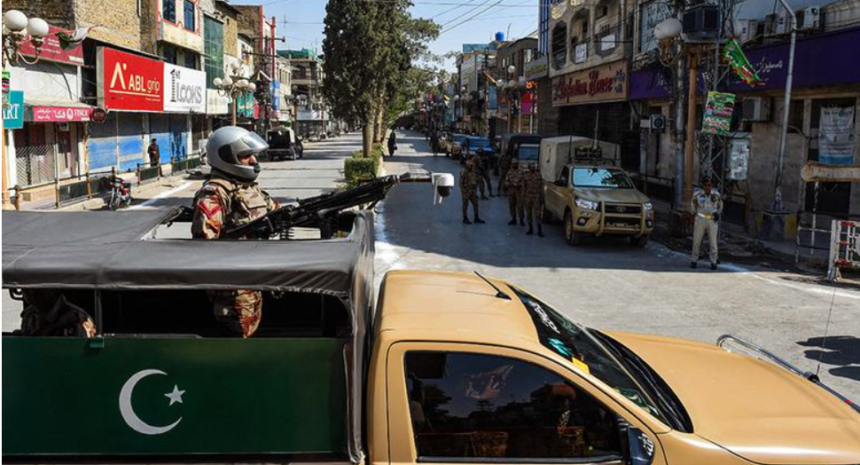Balochistan, the largest but least developed province of Pakistan, has been the site of continuous unrest for decades, primarily driven by the insurgency led by Baloch separatists. In a recent tragic incident, seven laborers were brutally killed by separatist militants in the province’s remote and restive region. The laborers, engaged in various development projects aimed at improving the infrastructure in this historically marginalized province, became the latest victims of a conflict that shows no signs of abating.
This incident has sparked renewed debates about the Balochistan conflict, Pakistan’s handling of the situation, the plight of civilians, and the role of external forces. In this comprehensive analysis, we will explore the context behind the violence, the history of the insurgency, the motivations of the separatists, the socio-political and economic factors contributing to the unrest, and the implications for Pakistan and the wider region.
The Recent Attack: What Happened?
In early 2024, seven laborers working in a remote area of Balochistan were killed by militants associated with Baloch separatist groups. These workers were employed in a construction project aimed at developing road infrastructure under Pakistan’s broader efforts to improve the region’s connectivity, particularly linked to the China-Pakistan Economic Corridor (CPEC). The laborers, who were non-Baloch, were ambushed while working on-site, a strategy separatists often employ to disrupt government-sponsored projects.
The attackers fled the scene after the killings, leaving behind a gruesome reminder of the volatility in the region. Local authorities and security forces reached the area hours after the incident, launching an investigation and sweeping operations to track down the perpetrators. However, the remote terrain and rugged landscape of Balochistan have always provided militants with safe havens, making it difficult for law enforcement to gain the upper hand.
The laborers’ deaths have sparked anger and fear among the workers engaged in similar projects throughout the province. Many have voiced concerns about the lack of adequate security, while others have temporarily halted work until assurances of protection are provided.
The Historical Context of the Balochistan Insurgency
The insurgency in Balochistan is deeply rooted in history, dating back to the early years of Pakistan’s independence. Balochistan, with its vast mineral resources and strategic location, has long been seen as vital for Pakistan’s economic and security interests. However, the province’s inhabitants, particularly the ethnic Baloch population, have often felt neglected, marginalized, and excluded from the benefits of its resources.
Since the 1950s, several waves of insurgency have erupted in Balochistan, each motivated by demands for greater autonomy, control over natural resources, and in some cases, full independence from Pakistan. The current wave of insurgency, which began in the early 2000s, has been the most intense and long-lasting. The Baloch insurgent groups, particularly the Balochistan Liberation Army (BLA) and Baloch Republican Army (BRA), have led guerrilla-style attacks against Pakistani security forces, government infrastructure, and projects that they perceive as exploiting Balochistan’s resources without benefiting the local population.
The laborers killed in the recent attack were part of a long list of victims targeted by insurgents as part of their broader strategy to disrupt state-sponsored development projects. These groups argue that such projects, including the multi-billion-dollar CPEC initiative, benefit external actors, including China, rather than the people of Balochistan.
Baloch Separatists’ Motivations and Objectives
Baloch separatists have consistently argued that Balochistan’s natural wealth, including its vast reserves of natural gas, coal, and minerals, has been exploited by the Pakistani state while the local population remains impoverished and underdeveloped. Despite being the largest province in terms of area, Balochistan remains one of the least developed regions of Pakistan, with high levels of poverty, illiteracy, and unemployment.
The separatist groups have framed their struggle as a fight for self-determination and control over the province’s natural resources. They argue that the people of Balochistan have been systematically marginalized in terms of political representation, economic development, and access to basic services such as healthcare and education. These grievances have fueled the insurgency, with militant groups seeking to force the Pakistani state into granting greater autonomy or, in some cases, allowing Balochistan to secede.
In recent years, the insurgents have also increasingly targeted non-Baloch laborers and workers involved in government-sponsored projects. These attacks are designed to discourage development initiatives that the militants view as exploitative and as a means for the central government to tighten its control over the region. The China-Pakistan Economic Corridor (CPEC), which passes through Balochistan and involves major infrastructure and energy projects, has been a particular focus of attacks, as separatists believe it further entrenches the province’s exploitation.
The Impact of the Insurgency on Development and Stability
The persistent insurgency has had devastating consequences for Balochistan’s development. While the province is rich in natural resources, its potential remains largely untapped due to the security situation. Energy projects, mineral extraction, and infrastructure development have all been severely hampered by the ongoing conflict. Investors and workers alike are wary of operating in the region due to the constant threat of attacks by insurgent groups.
One of the most significant casualties of the insurgency has been the China-Pakistan Economic Corridor (CPEC), a flagship project under China’s Belt and Road Initiative (BRI). CPEC, which includes highways, railways, and energy projects, is aimed at improving connectivity between China and Pakistan, with the strategic Gwadar port in Balochistan playing a central role. However, separatists view CPEC as a project that primarily benefits China and Pakistan’s central government while sidelining the local Baloch population.
Insurgent groups have attacked CPEC-related projects and personnel, resulting in delays and increased security costs. These attacks have also led to the deployment of thousands of additional Pakistani security forces to the region, further militarizing the province and heightening tensions between the local population and the state.
Pakistan’s Response to the Balochistan Insurgency
Pakistan’s response to the insurgency has been multifaceted, combining military operations with development initiatives. The government has deployed a significant number of troops to Balochistan, launching numerous operations aimed at dismantling insurgent networks and restoring order. These operations have had some success in reducing large-scale attacks, but the insurgents have adapted by shifting to guerrilla-style tactics, targeting infrastructure, security personnel, and civilian workers in hit-and-run attacks.
On the development front, the Pakistani government has launched various projects aimed at improving Balochistan’s infrastructure, education, and healthcare systems. The government has argued that these projects, including CPEC, are crucial for bringing much-needed development to the province and improving the lives of its residents. However, the separatists’ attacks on these projects have hindered progress, and the perception among many Baloch people is that the benefits of these initiatives do not reach the local population.
The central government has also attempted to engage in dialogue with moderate Baloch leaders in an effort to bring about political reconciliation. However, these efforts have been largely unsuccessful, as the most hardline factions of the insurgency reject any form of compromise with the Pakistani state. Many Baloch leaders in exile, including those affiliated with the BLA and BRA, continue to demand either complete independence or significant autonomy, which the Pakistani government is unwilling to grant.
The Human Cost of the Conflict
The ongoing conflict in Balochistan has had a devastating impact on the civilian population. Thousands of people have been killed in the insurgency, including security personnel, militants, and civilians. Many more have been displaced as a result of the violence, with entire communities uprooted by military operations and insurgent attacks.
The laborers targeted in the recent attack were among the most vulnerable victims of the conflict. Like many workers in Balochistan, they had come from other parts of Pakistan in search of employment, only to find themselves caught in the crossfire of a violent insurgency. Their deaths underscore the ongoing risks faced by those working in the province’s development projects, as well as the broader challenges of bringing stability to the region.
The conflict has also created a climate of fear and mistrust between the local population and the Pakistani state. The heavy presence of security forces, combined with the ongoing insurgency, has made daily life difficult for many Baloch residents. The militarization of the province, along with frequent curfews and checkpoints, has created a sense of alienation among the local population, further fueling resentment towards the state.
The Role of External Forces
The Balochistan insurgency is not solely a domestic issue. External forces have also played a role in shaping the conflict, with accusations of foreign support for the insurgents. Pakistani authorities have long accused India of providing support to Baloch separatists, a claim that India denies. The Pakistani government argues that India seeks to destabilize Pakistan by fueling the insurgency in Balochistan, particularly as part of a broader regional rivalry between the two countries.
Additionally, the strategic location of Balochistan, particularly its proximity to the Persian Gulf and the Strait of Hormuz, has attracted the attention of global powers. The Gwadar port, a key component of CPEC, is seen as critical for China’s maritime ambitions in the region. This has made Balochistan a focal point for geopolitical competition, further complicating efforts to resolve the conflict.
The Way Forward: Prospects for Peace
The killing of the seven laborers is a stark reminder of the ongoing challenges facing Balochistan. As the insurgency drags on, there are no easy solutions to the conflict. A comprehensive approach is needed, one that addresses both the security and political dimensions of the crisis. For Pakistan, this means continuing its efforts to improve security in the region while also addressing the grievances of the Baloch population.
At the same time, the government must find ways to ensure that development projects in the province, including CPEC, benefit the local population. Without tangible improvements in the lives of Baloch residents, the insurgency is likely to continue. Engaging in meaningful dialogue with moderate Baloch leaders and offering greater political and economic autonomy may provide a path towards peace.
The international community also has a role to play in supporting efforts to resolve the conflict. External powers must refrain from fueling the insurgency for their own geopolitical interests and instead encourage dialogue and reconciliation between the Pakistani state and Balochistan’s leaders.
In the end, the path to peace in Balochistan will require both a military and political solution. Only by addressing the root causes of the conflict – including the marginalization of the Baloch people and their lack of control over their own resources – can lasting stability be achieved in this troubled region ALSO READ:- At Least 13 Wounded in Southern Ukraine as Russian Air Strikes Escalate: An In-Depth Analysis





